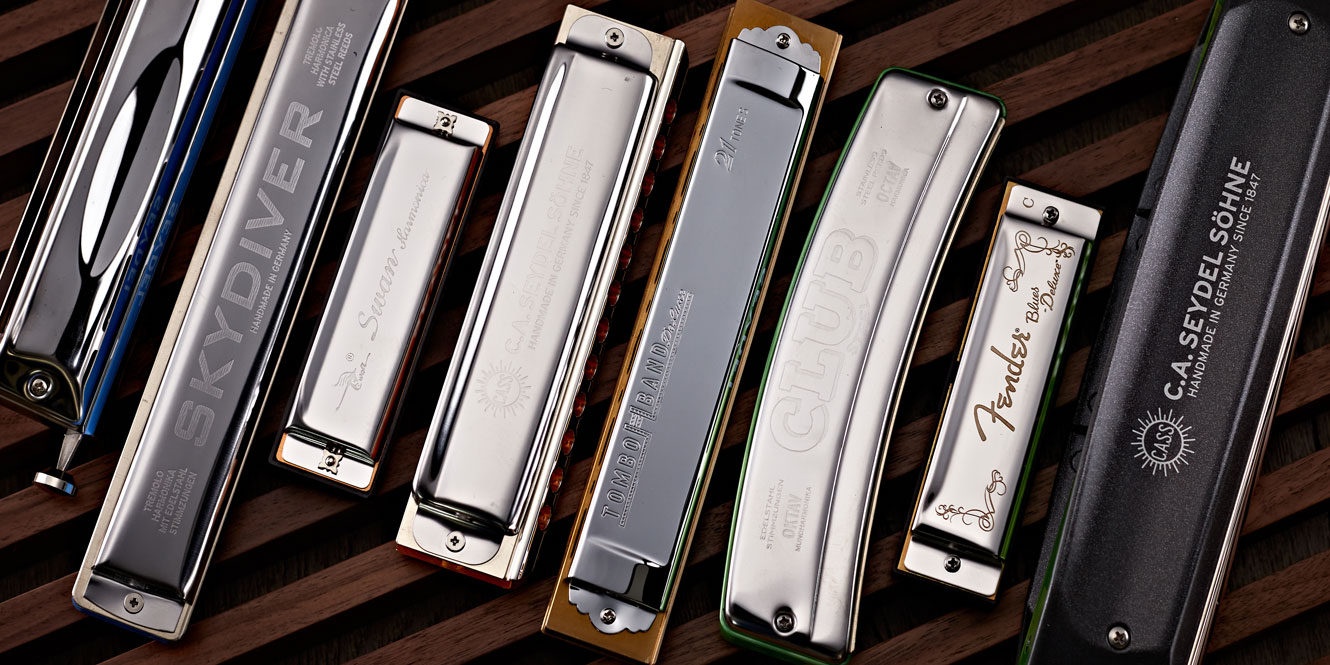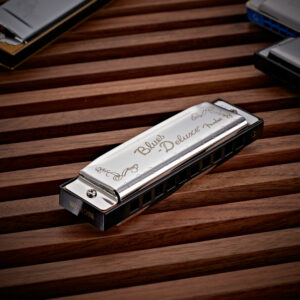The harmonica is a staple in blues music, playing a large part in defining the sound of the genre since the 1930s. It wasn’t until just after World War 2, however, that the instrument really started to gain popularity, with Jerry Murad’s Harmonicats, Sonny Boy Williamson II, and Little Walter cementing the harmonica in blues music.
These musicians paved the way for future harmonica players of many genres, particularly folk music and the likes of Bob Dylan. The instrument has also made appearances in rock and pop, (think Billy Joel’s “Piano Man” and The Beatles’ “Love Me Do”). It might be small, but the harmonica is certainly mighty.
The beauty of the harmonica is that it’s easy to practise with – it’s about the size of your hand and you can pick it up and take it with you anywhere. But the techniques can take time to master – which is why we’re here to teach you how to play the harmonica.
We’ll look at the basics of the harmonica, which one might be best for you, techniques every beginner should know, and how to maintain your instrument.
Key takeaways
If you’re playing harmonica for the first time our advice is to follow these three top tips:
- Ensure you know the basic parts of the harmonica first – this will help you understand how the harmonica works
- Use proper playing techniques and hold the harmonica correctly – the right technique will minimise bad playing habits and save you time when learning complex pieces of music
- Play pieces you enjoy – while learning technique is important, it’s just as crucial to have fun!
Types of harmonicas
There are a few types of harmonicas, and each one is suited to different styles and techniques. Diatonic harmonicas are the most common, built for blues, folk, and rock. They’re tuned to a specific key and are ideal for bending notes (a key feature of blues music).
Great examples of diatonic harmonicas are the playLITE Harmonica, the Fender Blues Deluxe Harmonica, A, and the Harmonica by Gear4music
Chromatic harmonicas like the Seydel Saxony Chromatic Harmonica Orchestra C offer more versatility, with a button-activated slide that lets you play any note in the chromatic scale. This makes them perfect for jazz and classical music, which often contain more complex passages and note runs.
In contrast, tremolo harmonicas have two reeds per note (we’ll cover the anatomy of a harmonica in the next section), slightly detuned to create a vibrating, ‘warbling’ sound. They’re popular in traditional folk music across Asia and Europe. Octave harmonicas also have two reeds per note but are tuned an octave apart, resulting in a fuller, richer sound. They’re often used in folk music, too.

Parts of the harmonica
A harmonica has a few essential parts. The cover plates are the outer layers that protect the instrument’s internal components and help amplify its sound. Beneath these are the reed plates, which hold the metal reeds responsible for creating notes as you blow or draw air. These reeds vibrate to produce different pitches.
The comb sits between the reed plates, creating separate chambers for each reed. It’s usually made from plastic, wood, or metal, impacting the tone and resonance.
How to play the harmonica
1. Prepare your lips to play the instrument
Preparing your lips is crucial for producing a clear sound on the harmonica. Start by lightly moistening your lips – this helps them glide smoothly across the harmonica’s surface, reducing friction. Then, relax your lips and facial muscles to avoid tension, which can impact your tone and control.
Try to keep your lips soft and slightly open, creating a gentle seal over the holes. This relaxed position makes it easier to isolate notes and improves overall playability.
2. Position the harmonica
Hold the harmonica with your left hand, angling it slightly upwards towards the sky. This tilt helps with airflow and encourages a comfortable playing posture.
Place your upper lip gently over the top of the harmonica, covering the top holes. Your bottom lip should be relaxed beneath it, softly sealing around the bottom holes. This positioning allows you to create a proper seal, which is essential for accurate note production. Keep your grip and lips loose to prevent strain and maintain flexibility while you play.
3. Practice basic techniques
To start playing the harmonica, you’ll need to learn some fundamental techniques like the pucker and tongue methods – these will help you master the basics before you move on to more complex music.
The pucker method requires you to shape your lips into an “O” to isolate individual holes in the harmonica. It’s straightforward and ideal for beginners aiming to play single notes, but it may require extra control for precise notes.
For the tongue method (or tongue blocking), cover multiple holes with your lips and use your tongue to block unwanted notes. This technique allows for more complex sounds, like chords and splits, but it’s trickier to master than the pucker method.
Both methods are useful, so practising each expands your versatility.

4. Try an easy harmonica song
The most important thing to remember when learning any instrument is to practise slowly. This way, you’ll build control and accuracy – and these are crucial to playing the harmonica.
Use harmonica tabs, which guide you through songs using simple notation. The letter B means blow (exhale into the harmonica), while D means draw (inhale). Gradually speed up as you gain confidence, ensuring each note is clear and steady before moving faster.
Our top three piano songs for beginners are The Beatles’ “Love Me Do”, Billy Joel’s “The Piano Man”, and Bob Dylan’s “Mr Tambourine Man”. For a comprehensive list of song choices, check out our guide to easy harmonica songs.
5. Practise bending notes
Bending notes is an essential harmonica technique, especially in blues music. To bend a note, start by inhaling or exhaling through a single hole, then adjust the shape of your mouth and tongue. Try lowering the back of your tongue slightly and moving it backwards – this creates a change in airflow that makes the pitch drop.
The controlled airflow produces the signature “wailing” sound of bent notes, adding emotional depth to your playing. Practise slowly, experimenting with different mouth shapes. With time, you’ll gain control over the pitch and add expression to your music.
6. Play in different positions
Playing in different positions on the harmonica allows you to explore a range of keys and musical styles. Many harmonicas have one key printed on the instrument, indicating the first position, which is the natural key of the harmonica. In the first position, also known as straight harp, you play mostly simple melodies such as those in traditional folk music.
The second position, or cross harp, is a fifth up from the harmonica’s natural key. This position shifts the focus to different notes, particularly the draw notes. The second position is popular in blues, rock, and jazz, allowing for deeper bends and more soulful expressions.
There’s also the fourth position, used less commonly, which creates a minor tonality suitable for some jazz and world music.
Some harmonicas have dual key markings, such as “C” and “G” for the first and second positions, helping you shift positions more intuitively. Learning to switch between positions expands your versatility, letting you adapt to various musical styles and play alongside different instruments.

How to clean your harmonica
 Cleaning your harmonica regularly helps keep it in good condition and maintains sound quality. Start by gently tapping the harmonica on a clean surface to remove excess moisture after each use.
Cleaning your harmonica regularly helps keep it in good condition and maintains sound quality. Start by gently tapping the harmonica on a clean surface to remove excess moisture after each use.
For a deeper clean, separate the harmonica into its main parts: the cover plates, reed plates, and comb (though this may vary if your harmonica has a non-removable comb).
Soak the cover plates in warm soapy water, gently scrubbing with a soft brush. For the comb, avoid soaking if it’s wooden, as water can damage it; instead, use a damp cloth. Clean the reed plates carefully with a soft brush or cotton swab, avoiding too much moisture.
After cleaning, rinse the metal parts with distilled water to remove soap residue, then dry each part thoroughly before reassembling.
Dedicated polishing cloths can be used for maintenance top-ups or deep cleaning. We recommend using one to wipe your instrument after every use, regularly removing moisture, oil, and dust.
For quick yet thorough cleaning, the Harmonica Disinfection Bag is a nifty accessory to keep around. It removes 99% of bacteria in five minutes – all you have to do is place your harmonica in the disinfectant bag.
FAQs
Is the harmonica easy to learn?
The harmonica is easy to learn at a basic level, but more advanced techniques can take a lot of time and skill. Thanks to its compact design and straightforward note structure, beginners can start playing simple tunes relatively quickly. The technique, like breath control and bending notes, can be picked up with practice, making it accessible for all ages.
How do I start playing harmonica?
To start playing harmonica, you’ll need a harmonica in the key of C, which is ideal for beginners. Prepare your lips and position the harmonica correctly, then practise basic single-note techniques.
What is the easiest harmonica song to play?
“Love Me Do” by The Beatles is one of the easiest harmonica songs to play, and one of the most recognisable in pop and rock music. Its melody is simple and repetitive, making it ideal for beginners.
Final thoughts
Harmonicas are a great instrument to play – they require very little maintenance than other instruments, are possibly one of the most portable instruments, and can be very affordable. Knowing how to play the harmonica is an impressive skill to have, and hopefully, you’ve now picked up the basics!
For more woodwind content, check out these related articles:
Instruments in the Woodwind Family
The 8 Best Instruments for Kids














0 Comments